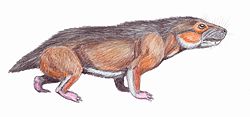
Cynognathus is an extinct genus of large-bodied cynodontian therapsids that lived in the Middle Triassic. It is known from a single species, Cynognathus crateronotus. Cynognathus was a 1.2-metre long predator closely related to mammals and had a southern hemispheric distribution. Fossils have so far been recovered from South Africa, Argentina, Antarctica, and Namibia.

Thrinaxodon is an extinct genus of cynodonts, most commonly regarded by its species T. liorhinus which lived in what are now South Africa and Antarctica during the Early Triassic. Thrinaxodon lived just after the Permian–Triassic mass extinction event, its survival during the extinction may have been due to its burrowing habits.

The Cynognathus Assemblage Zone is a tetrapod assemblage zone or biozone which correlates to the Burgersdorp Formation of the Beaufort Group, a fossiliferous and geologically important geological Group of the Karoo Supergroup in the Karoo Basin of South Africa. The thickest outcrops of this biozone, reaching approximately 600 metres (2,000 ft), occur between Queenstown and Lady Frere in the Eastern Cape. Outcrops then thin out to between 200 and 100 metres around Aliwal North, Burgersdorp, Steynsburg, and Rouxville. Thin outcrops are also found in areas in the Free State that border Lesotho. The Cynognathus Assemblage Zone is the eighth and youngest of the eight biozones found in the Beaufort Group, and is considered to be early Middle Triassic.

Euchambersia is a genus of therocephalian therapsid that lived during the Late Permian, approximately 255 million years ago, in what is now South Africa. The genus contains a single species, Euchambersia mirabilis, named by paleontologist Robert Broom in 1931 from a skull missing the lower jaws; a second skull, belonging to an immature individual, was later described. It is a member of the family Akidnognathidae, which historically has also been referred by as the synonymous Euchambersiidae.

Bauria is an extinct genus of the suborder Therocephalia that existed during the Early Triassic period, around 246-251 million years ago. It belonged to the family Bauriidae. Bauria was probably a carnivore or insectivore. It lived in South Africa, specifically in the Burgersdorp Formation in South Africa.
Moschorhinus is an extinct genus of therocephalian in the family Akidnognathidae, with only one species: M. kitchingi. It was a carnivorous, lion-sized synapsid which has been found in the Late Permian to Early Triassic of the South African Karoo Supergroup. It had a broad, blunt snout which bore long, straight canines. It appears to have replaced the gorgonopsids ecologically, and hunted much like a big cat. While most abundant in the Late Permian, it survived a little after the Permian Extinction, though these Triassic individuals had stunted growth.
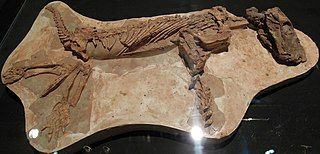
Viatkogorgon is a genus of gorgonopsian therapsid that lived during the Permian period in what is now Russia. The first fossil was found at the Kotelnich locality near the Vyatka River and was made the holotype of the new genus and species V. ivachnenkoi in 1999. The genus name refers to the river and the related genus Gorgonops—the gorgons of Greek mythology are often referenced in the names of the group. The specific name honors the paleontologist Mikhail F. Ivakhnenko. The holotype skeleton is one of the most complete gorgonopsian specimens known and includes rarely preserved elements such as gastralia and a sclerotic ring. A larger, but poorly preserved specimen has also been reported.

Theriognathus is an extinct genus of therocephalian therapsid belonging to the family Whaitsiidae, known from fossils from South Africa, Zambia, and Tanzania. Theriognathus has been dated as existing during the Late Permian. Although Theriognathus means mammal jaw, the lower jaw is actually made up of several bones as seen in modern reptiles, in contrast to mammals. Theriognathus displayed many different reptilian and mammalian characteristics. For example, Theriognathus had canine teeth like mammals, and a secondary palate, multiple bones in the mandible, and a typical reptilian jaw joint, all characteristics of reptiles. It is speculated that Theriognathus was either carnivorous or omnivorous based on its teeth, and was suited to hunting small prey in undergrowth. This synapsid adopted a sleek profile of a mammalian predator, with a narrow snout and around 1 meter long. Theriognathus is represented by 56 specimens in the fossil record.

Kombuisia is a genus of dicynodont from Early to Middle Triassic of South Africa and Antarctica. Two species were described for the genus: Kombuisia frerensis (type) and Kombuisia antarctica.

Bauriidae is an extinct family of therocephalian therapsids. Bauriids were the latest-surviving group of therocephalians after the Permian–Triassic extinction event, going extinct in the Middle Triassic. They are among the most advanced eutherocephalians and possess several mammal-like features such as a secondary palate and wide postcanine teeth at the back of the jaws. Unlike other therocephalians, bauriids were herbivorous. They were also smaller than earlier members of the group. Two subfamilies are classified within Bauriidae: Nothogomphodontinae and Bauriinae.
Blattoidealestes is an extinct genus of therocephalian therapsid from the Middle Permian of South Africa. The type species Blattoidealestes gracilis was named by South African paleontologist Lieuwe Dirk Boonstra from the Tapinocephalus Assemblage Zone in 1954. Dating back to the Middle Permian, Blattoidealestes is one of the oldest therocephalians. It is similar in appearance to the small therocephalian Perplexisaurus from Russia, and may be closely related.

Karenites is an extinct genus of therocephalian therapsids from the Late Permian of Russia. The only species is Karenites ornamentatus, named in 1995. Several fossil specimens are known from the town of Kotelnich in Kirov Oblast.
Titanogomphdon is an extinct genus of diademodontid cynodonts from the Middle Triassic Omingonde Formation of Namibia. It is known from a single partial skull that was described in 1973 from the Omingonde Formation. The type and only species is Titanogomphodon crassus. At about 40 centimetres (16 in), the skull of Titanogomphodon was significantly larger than that of its closest relative, Diademodon. Its teeth are similar to those of another group of cynodonts called Traversodontidae, but the similarities are likely the result of convergent evolution. Aside from its larger size, Titanogomphodon differs from Diademodon in having a bony projection on the postorbital bar behind the eye socket.

Cricodon is an extinct genus of trirachodontid cynodonts that lived during the Early Triassic and Middle Triassic periods of Africa. A. W. Crompton named Cricodon based on the ring-like arrangement of the cuspules on the crown of a typical postcanine tooth. The epithet of the type species, C. metabolus, indicates the change in structure of certain postcanines resulting from replacement.
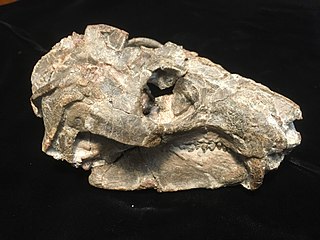
Aleodon is an extinct genus of cynodonts that lived from the Middle to the Late Triassic. Relatively few analyses have been conducted to identify the phylogenetic placement of Aleodon, however those that have place Aleodon as a sister taxon to Chiniquodon. Two species of Aleodon are recognized: A. brachyramphus which was discovered in Tanzania, and A. cromptoni which was discovered most recently in Brazil.
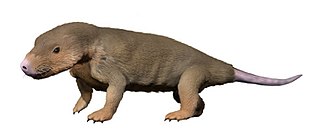
Abdalodon is an extinct genus of late Permian cynodonts, known by its only species A. diastematicus.Abdalodon together with the genus Charassognathus, form the clade Charassognathidae. This clade represents the earliest known cynodonts, and is the first known radiation of Permian cynodonts.
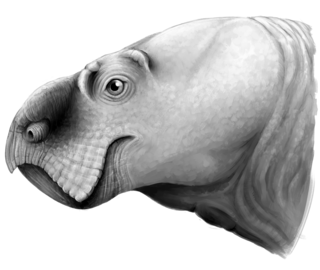
Ufudocyclops is an extinct genus of stahleckeriid dicynodont from the Middle Triassic of South Africa. It was found in the Burgersdorp Formation, part of the uppermost Cynognathus Assemblage Zone of the Beaufort Group in the Karoo Basin. The type and only known species is U. mukanelai. It was a large, beaked herbivore like other Triassic dicynodonts, lacking tusks, and is mostly characterised by unique features of the skull. It is known from three specimens, two of which were previously referred to the Tanzanian dicynodont Angonisaurus. The separation of Ufudocyclops from Angonisaurus indicates that the Middle Triassic fauna of the Beaufort Group in South Africa was not part of a larger shared fauna with those of the Manda Beds in Tanzania, as was previously supposed, and suggests that they were separated as more localised faunas, possibly by geographic barriers or in time. Ufudocyclops then would have been a unique part of the uppermost Cynognathus Assemblage Zone in South Africa. It is also the oldest known member of the family Stahleckeriidae, and implies that the family was already diversifying in the Middle Triassic alongside other kannemeyeriiforms, not just in the Late Triassic after other families died out.
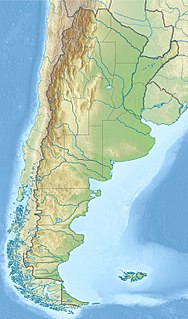
The Río Seco de la Quebrada Formation is a Triassic geological formation in Mendoza Province, Argentina. Fossils of cynodonts such as Cynognathus, Diademodon, and Pascualgnathus have been found in this formation, along with dicynodonts such as Vinceria and Acratophorus. Based on biostratigraphy, the Río Seco de la Quebrada Formation is considered to have formed during the Anisian stage, as it shares fauna with the upper subzones of the Cynognathus Assemblage Zone in South Africa. However, radiometric dating controversially argues that it was deposited during the early Carnian stage, 10 million years younger than expected otherwise.

Etjoia is an extinct genus of traversodontid cynodonts that lived during the Middle Triassic or Late Triassic period in southern Africa. This medium-sized omnivorous cynognathian provides important information on the dental evolution of early diverging gomphodonts and traversodontids.
Ictidosaurus was a therapsid genus found in the Abrahamskraal Formation of South Africa, which lived during the middle Permian period. Fossils of the type species were found in the Tapinocephalus, and the base of the Eodicynodon assembly zones, of the Karoo Basin. Older classifications of the species, along with many other specimens found in the Iziko South African Museum archives, were originally classified within therocephalian family names, in this case the Ictidosauridae, which has been reclassified as belonging to the Scylacosauridae. The type species is I. angusticeps.
